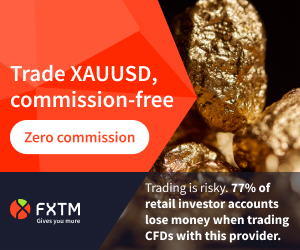While the popularity of CFD trading has grown steadily over the years, it spiked during the pandemic as a global phenomenon. Some studies show that interest in CFD trading skyrocketed 193% in 2020. Wondering why traders are choosing this instrument to speculate the financial markets? Let’s find out what CFD trading is, its inherent advantages and risks, and how it works.
What is CFD Trading?
Contracts for difference (CFDs) are derivatives, which means their value is derived from an underlying asset. For instance, gold CFDs derive their price from the yellow metal. CFDs offer a way to gain exposure to price movements in the underlying asset without the need to buy or sell it. For instance, if you’re bullish about gold prices rising from $1,700 to $1,800 , you can trade this difference in price using gold CFDs, without buying and holding gold until you sell it.
What are the Pros and Cons of CFD Trading?
Start small: Since you’re speculating on the difference in the price of an asset between the time the contract opens and closes, you can begin trading with a much smaller amount than buying the asset outright. For example, if you expect gold prices to rise from $1,760 to $1,770, you’re trading with $10, and don’t need $1,760 to buy an ounce of gold.
Access to a larger range of assets: There are CFDs for a variety of asset classes, including equities, indices, forex, commodities and cryptocurrencies. Moreover, CFDs allow you to trade assets that you otherwise may not have access to. For instance, day traders can access oil and other commodities with CFDs. This means you can trade all the major markets of the world, around the clock, from a single platform.
Trading opportunities in rising and falling markets: With CFDs, you can speculate on price movements in either direction (rising and falling), which means there are trading opportunities in both bullish and bearish markets.
Using leverage: CFDs offer much higher leverage than traditional trading, which allows you to gain the desired market exposure by depositing only a small fraction of the total value of your trade. For some underlying assets, the leverage could be as high as 500:1.
How Does Leverage Work in CFD Trading?
Let’s try to understand how leverage works and how it magnifies your profits if the market moves in the direction you had expected, or increases your risk if the market moves in the opposite direction.
Let’s say, you’re bullish about Tesla’s stock and wish to speculate on 10 shares. At $1,000 per share, the value of this exposure is $10,000. If you purchase these shares outright, you’ll need to find $10,000. Now, Tesla reports strong earnings and the stock rallies from $1,000 to $1,010. If you decide to sell the shares, you make a profit of $10 per share. Your total profit is $100. You made $100 on an investment of $10,000, which means your profit percentage is ($100/$10,000)*100, or 1%.
Keeping the total size of your position at 10 Tesla shares, let’s use leverage of 100:1. This means you need only $100 to gain exposure to $10,000 worth of Tesla stock. The broker lends you the remaining amount of $9,900. When the share price rises from $1,000 to $1,010 and you close the position, you still earn $10 per share, or $100 in total. However, you made $100 by depositing only $100 to open the CFD position. This means your profit percentage is ($100/$100)*100, or 100%.
Expert tip
When trading CFDs using leverage, it’s even more important to deploy robust risk management techniques, like stop loss and take profit, with every trade.
Another advantage of leverage is that it frees up your funds, which you can use to place other trades.
The Mechanics of CFD Trading
With CFDs, you can speculate on either direction of price movements of your chosen asset. If you expect the price to rise, you can open a long (or buy) position using CFDs. In case you expect prices to decline, you open a short (or sell) position. If the market moves in your expected direction, you earn a profit when the contract closes. In case the market moves in an unfavourable direction, you make a loss when the contract closes.
CFDs are traded in standardised contracts, known as lots. The lot size depends on the underlying asset being traded. CFDs typically do not have a fixed expiry, which means the position remains open till you choose to close it. To close the position, you are effectively opening another position in the opposite direction. For instance, if you had opened a long CFD position in silver after which silver prices rallied, you would be placing a sell trade to close your original long position to realise your profit.
The Mechanics of CFD Trading
To calculate the profit or loss on a CFD trade, you will need:
- The standard size of 1 lot (also called the tick size)
- The price of 1 lot (also called the tick value)
- The price of the instrument when you opened the position
- The price of the instrument when you closed the position
With this information, here are the steps to calculate the profit or loss on a CFD trade:
Step 1
Calculate the deal size by multiplying the tick size by the number of ticks (lots) you purchased.
Step 2
Multiply the deal size by the tick value.
Step 3
Multiply the figure achieved in step 2 by the difference between the price of the asset when you closed the position and when you opened it.
Profit or Loss = (deal size x tick value) x (closing price – opening price)
For instance, you purchased 50 Amazon CFDs with a tick size of 1, having a tick value of 1 USD. You opened the position when Amazon’s share price was $200 and closed the position when the share price reached $210.
Your profit will be calculated as: (50 x 1) x (210 – 200) = $500.
If, however, Amazon’s share price falls from $200 to $190, your loss will be calculated as: (50 x 1) x (190 – 200) = -$500.
From this figure, you can also deduct any associated costs, like overnight fees, to arrive at your actual profit or loss amount.
Key Takeaways
- CFD trading allows you to trade price movements of an asset without buying or owning the underlying asset.
- With CFDs, you can find trading opportunities in both rising and falling markets.
- CFDs trade on leverage, which magnifies your profits, but also increases your risks.
- With both long and short positions, your profit or loss is realised only when the position is closed.
Open a live account with ADSS and get access to the world’s largest assets with CFD trading.
Disclaimer: This article is an educational guide to CFD trading and the financial markets and should not be considered as advice. Trading CFDs is high risk. Always ensure you understand the potential risks and rewards associated with trading before you trade.














